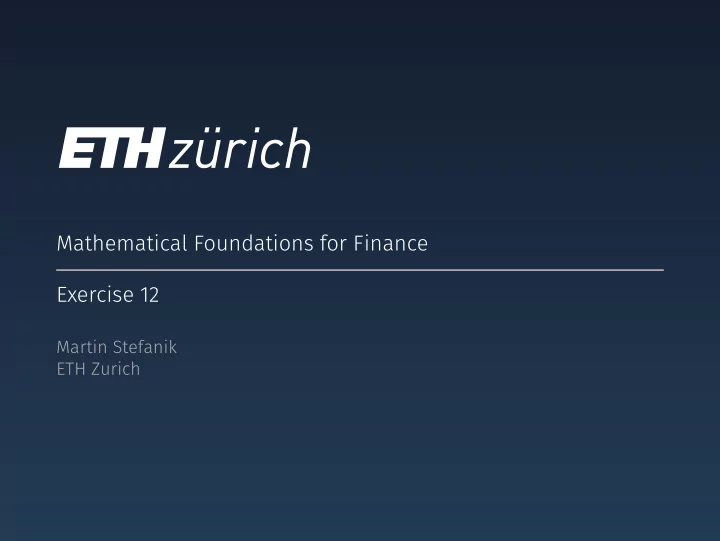

Mathematical Foundations for Finance Exercise 12 Martin Stefanik ETH Zurich
Itô Representation Theorem Theorem 1 (Itô representation theorem) time. P-a.s. 0 1 / 6 Let F W = ( F W t ) 0 ≤ t ≤∞ denote the filtration generated by a Brownian motion W augmented by P -nullsets in F 0 ∞ = σ ( W s , s ≥ 0 ) . Suppose that W = ( W t ) t ≥ 0 is a Brownian motion in R m , m ∈ N . Then every random variable H ∈ L 1 ( F W ∞ , P ) has a unique representation as ∫ ∞ H = E [ H ] + ψ s dW s for an R m -valued integrand ψ ∈ L 2 loc ( W ) with the additional property that ∫ ψ dW is a ( P , F W ) -martingale on [ 0 , ∞ ] . • We can also make this work for a finite time horizon T > 0 by replacing ∞ by T > 0. • Note that this is precisely of the form V 0 + G ( ψ ) that we saw in discrete
Itô Representation Theorem Corollary 2 that can live in our probability space. if we want to be able to define say (compensated) Poisson process on that space. 2 / 6 1. Every (real-valued) local ( P , F W ) -martingale L is of the form ∫ L = L 0 + γ dW for some R m -valued process γ ∈ L 2 loc ( W ) 2. Every local ( P , F W ) -martingale is continuous. • This provides a simple characterization of every local ( P , F W ) -martingale • It also gives an indication that our probability space needs to be richer
Introduction to Black-Scholes Model S 1 of time, respectively. mean and volatility of the logarithmic return of the stock over one unit the relative change in the price over an infinitesimal time step “dt”. that s 1 0 s 1 The Black-Scholes model is a continuous-time analogue of the symmetric S 1 S 1 S 1 3 / 6 multiplicative binomial model (also called the Cox-Ross-Rubinstein model). S 0 This model can be described by the following set of SDEs S 0 S 0 d � t = � � t rdt , 0 = 1 d � t = � t µ dt + � � 0 = � t σ dW t for some constants r , µ ∈ R and � 0 , σ > 0. • r ∈ R corresponds to continuously compounded interest rate, so if we take r ′ > − 1 as the simple interest rate from the CRR model, we obtain r = log( 1 + r ′ ) . • µ ∈ R and σ > 0 correspond to the mean growth rate and volatility of ( 2 σ 2 ) • An alternative interpretation is that µ − 1 and σ correspond to the
Introduction to Black-Scholes Model S 1 S 1 t S 1 If SDEs admit explicit solutions at all, they can sometimes be found by s 1 4 / 6 S 0 applying Itô’s formula to some f : ( x , t ) �→ f ( x , t ) in C 2 , 2 . For SDEs of the above form, f ( x ) = log( x ) is a good guess. We obtain � t = exp( rt ) (( ) 2 σ 2 ) � t = � 0 exp µ − 1 t + σ W t Defining logarithmic returns for t ∈ N as ( � ) L t = log , � t − 1 we have that L t are i.i.d random variables with ( ) L t ∼ N µ − 1 2 σ 2 , σ 2 , so the mean is µ − 1 2 σ 2 and standard deviation (volatility) is σ .
Introduction to Black-Scholes Model It is mentioned in the script that the Black-Scholes model as well as the CRR 5 / 6 are too simple to be realistic. Why? 0.15 0.10 0.05 0.00 −0.05 0 500 1000 1500 2000 0.15 0.10 0.05 0.00 −0.05 0 500 1000 1500 2000
Introduction to Black-Scholes Model 6 / 6 40 Empirical Black−Scholes 30 20 10 0 −0.06 −0.04 −0.02 0.00 0.02 0.04 0.06
Thank you for your attention!
Recommend
More recommend